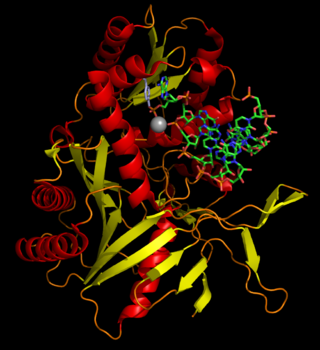Related Research Articles

Thermus is a genus of thermophilic bacteria. It is one of several bacteria belonging to the Deinococcota phylum. Thermus species can be distinguished from other genera in the family Thermaceae as well as all other bacteria by the presence of eight conserved signature indels (CSIs) found in proteins such as adenylate kinase and replicative DNA helicase as well as 14 conserved signature proteins (CSPs) that are exclusively shared by members of this genus.

Archaeoglobaceae are a family of the Archaeoglobales. All known genera within the Archaeoglobaceae are hyperthermophilic and can be found near undersea hydrothermal vents. Archaeoglobaceae are the only family in the order Archaeoglobales, which is the only order in the class Archaeoglobi.
Alteromonas is a genus of Pseudomonadota found in sea water, either in the open ocean or in the coast. It is Gram-negative. Its cells are curved rods with a single polar flagellum.

In taxonomy, Methanohalophilus is a genus of the Methanosarcinaceae.
In taxonomy, Haloplanus is a genus of the Halobacteriaceae.
In taxonomy, Halosimplex is a genus of the Halobacteriaceae.
Neorhizobium huautlense is a Gram negative root nodule bacterium. It forms nitrogen-fixing root nodules on Sesbania herbacea.
Aeromonas encheleia is a Gram-negative, motile bacterium of the genus Aeromonas isolated from European eels in Valencia, Spain.
Enhydrobacter is a genus of bacteria which belongs to the class Alphaproteobacteria. So far, only one species is known. Enhydrobacter has been discussed to be reclassified to the family Rhodospirillaceae and the class Alphaproteobacteria. Because of its oxidase positive it can not be placed in the family Enterobacteriaceae as it is not a parasite of birds or mammals.
Virgibacillus is a genus of Gram-positive, rod-shaped (bacillus) bacteria and a member of the phylum Bacillota. Virgibacillus species can be obligate aerobes, or facultative anaerobes and catalase enzyme positive. Under stressful environmental conditions, the bacteria can produce oval or ellipsoidal endospores in terminal, or sometimes subterminal, swollen sporangia. The genus was recently reclassified from the genus Bacillus in 1998 following an analysis of the species V. pantothenticus. Subsequently, a number of new species have been discovered or reclassified as Virgibacillus species.
Actinotignum schaalii is a bacterium first isolated from human blood cultures. Its type strain is CCUG 27420. It is a Gram-positive, facultative anaerobic coccoid rod, considered a human pathogen.
Prosthecomicrobium is a genus of aerobic bacteria which was isolated from freshwater samples.
Prosthecomicrobium pneumaticum is an aerobic bacterium from the genus of Prosthecomicrobium which has been isolated from freshwater.
Pseudarthrobacter defluvii is a bacterium species from the genus Pseudarthrobacter which has been isolated from sewage from the Geumho River near Daegu, Korea. Pseudarthrobacter defluvii has the ability to degrade 4-chlorophenol.
Arthrobacter luteolus is a bacterium species from the genus Arthrobacter which has been isolated from a human surgical wound in Belgium. Arthrobacter luteolus occurs in human clinical specimens.
Arthrobacter methylotrophus is a bacterium species from the genus Arthrobacter which has been isolated from soil around the roots of the plant Tagetes minuta.
Paenarthrobacter nitroguajacolicus is a bacterium species from the genus Paenarthrobacter which has been isolated from soil in the Czech Republic. Paenarthrobacter nitroguajacolicus has the ability to degrade 4-nitroguaiacol.
Cryomorphaceae is a family of bacteria in the order Flavobacteriales which occur in marine habitats.
Facklamia is a Gram-positive genus of bacteria from the family of Aerococcaceae. Facklamia bacteria are pathogens in humans.
Prauserella rugosa is a bacterium from the genus Prauserella which has been isolated from the rumen of cattle.
References
- ↑ LPSN lpsn.dsmz.de
- ↑ "Straininfo of Enhydrobacter aerosaccus". Archived from the original on 2014-02-23. Retrieved 2014-01-24.
- ↑ Staley, J. T.; Irgens, R. L.; Brenner, D. J. (1987). "Enhydrobacter aerosaccus gen. nov., sp. nov., a Gas-Vacuolated, Facultatively Anaerobic, Heterotrophic Rod". International Journal of Systematic Bacteriology. 37 (3): 289. doi: 10.1099/00207713-37-3-289 .
- ↑ "Enhydrobacter aerosaccus".
- ↑ Taxonomy Browser
- ↑ ATCC
- ↑ John G Holt (1 October 1993). Bergey's Manual of Determinative Bacteriology (9 ed.). Lippincott Williams & Wilkins. ISBN 0683006037.